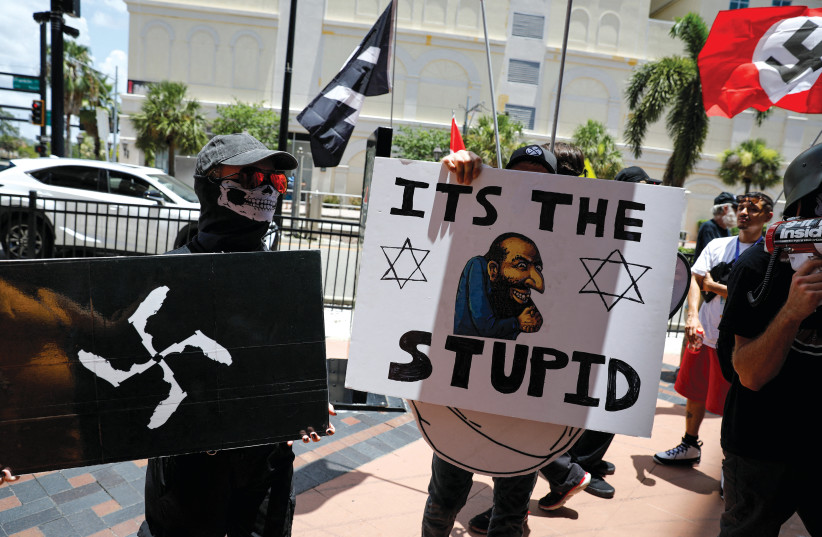Antisemitism is back in vogue: it’s moved out of the shadows and has become legitimate once more.
Hamas’s barbaric attack against Israel on October 7 unleashed a global wave of antisemitism unprecedented since the Holocaust, puncturing the illusion that antisemitism is a marginal intolerance relegated to the extreme Left, Right, or pockets of the Muslim world. What we’ve seen in the past five-plus months is an eruption of Jew-hatred across the civilized world from our neighbors, colleagues, academics, and otherwise normative people.
It’s hard to be the object of such hatred, and Jews and Israelis around the world have been caught completely off guard by this proverbial tightening of the noose.
Antisemitism on the rise around the world
At the University of Alberta, the head of the Sexual Assault Centre signed an open letter that denied allegations of rape by Hamas terrorists against Israeli women on October 7.
In Melbourne, Australia, a popular writer released a list of 600 local Jews who had joined a communal Whatsapp group to combat antisemitism and hate against Israel. Many of those local Jews received death threats.

In Zurich, Switzerland, an ultra-Orthodox man was stabbed and severely injured outside a synagogue by a teenager reportedly shouting “Death to all Jews.”
In the United States, a cafe in San Francisco denied entry to “Zionist” customers; an academic from Columbia University urged low-income tenants to stop paying rent to landlords with “ties to Israel”; a history professor at Cornell called the Hamas massacres “exhilarating” and a “breath of fresh air”; and the local city council in Oakland, CA aired blatant conspiracy theories claiming that October 7 was a “Zionist false flag operation” committed by the IDF.
It’s easy to talk about antisemitism as a phenomenon and to forget that prejudice and hate crimes against Jews are perpetrated by people: regular, everyday people.
Whether or not these people claim that their underlying motives are innocuous, innocent or simply manifestations of “anti-Zionism and not antisemitism” is a moot point.
Jews feel the hate, and each of these examples contributes to the climate of hate.
As Jewish people worldwide prepare to celebrate the festival of Purim, they commemorate a distant time and place when genocidal antisemitism threatened to destroy them. The story detailed in the Book of Esther no longer feels so distant.
In the multicultural milieu of ancient Persia, a high-ranking official named Haman is singularly obsessed and engulfed by his hatred of the Jews. He plots their destruction with the approval of the king, Ahasuerus. These plans are foiled by Queen Esther – a Jew who hides her identity in the royal palace – along with her cousin Mordechai, a Jewish leader who refuses to cower before Haman.
Haman’s nefarious plans are “unmasked” by Esther. Her identity is revealed. Mordecai’s role in saving the king in an earlier plot is discovered. Non-Jewish allies, such as Harbonah and Hatach step out of the shadows to display their support for the Jewish people and foil Haman’s plans.
Behind it all is the invisible hand of God, although unmentioned in the text, moving the events into place in perfect timing, ensuring, for example, that Ahasuerus happens to unearth Mordecai’s role in saving his life the very night that Haman comes to ask for Mordecai’s head.
To this day, Jews dress up and wear masks to symbolize this motif of “unmasking.”
As in the Purim story, today Jew haters worldwide have been unmasked with their bigotry on full display.
And as in the Purim story, principled non-Jewish allies have rushed to stand up to hate and to protect their Jewish neighbors. Three hundred thousand Jews and non-Jews rallied in Washington DC against antisemitism and in support of Israel; another 100,000 in Paris and tens of thousands in London.
History teaches us that although antisemitism starts with the Jews, it never ends with the Jews. Every society poisoned by antisemitism eventually turns on itself or unleashes it’s hatred outward, looking for new victims.
Millions of non-Jews were murdered by Nazis in the Holocaust, millions of non-Jews faced misery at the antisemitic and intolerant hands of the Soviet Union.
Ultimately, antisemitic societies become paralyzed by sickness and plagued by internal violence and chaos.
Today millions of citizens across the Muslim world live trapped in corrupt regimes that use hatred of Jews and Israel to distract from their own internal problems. Now, as the epidemic of antisemitism begins to infect Western society, that hate may come to tear away at these grand institutions and ideals, making everyone poorer for it, not just the Jews.
Jews will ultimately survive and outlive this bout of antisemitism – as the Purim story teaches us. We have 3,000 years of experience in doing so. The real question is whether wider society will take note of the canary in the coal mine and realize that by marginalizing the Jews, they are essentially marginalizing themselves.
Antisemitism is not just a Jewish problem.
It’s first and foremost a non-Jewish problem. It’s symptomatic of something deeper.
By not fighting antisemitism head-on, all of society – Jews and non-Jews alike – are ultimately dragged down as the slow process of decay tears away at the foundations of everything we hold dear.
The message of Purim shows us that another way is possible: Those who stand up to hate can and will prevail.
The writer is a Center for Jewish Impact (CJI) fellow.
